R v HEVKO [2018] SASCFC 22: Analyzing Home Detention Bail Order
VerifiedAdded on 2023/06/12
|6
|1410
|464
Case Study
AI Summary
This case study provides an in-depth analysis of the R v HEVKO [2018] SASCFC 22 case, where the appellant was convicted of drug trafficking. The analysis focuses on the Supreme Court of Australia's decision regarding the home detention order initially granted by the district court. The court identified errors in the district court's application of sentencing guidelines, particularly concerning the safety of the community and the assessment of the appellant's offense. The study examines the factual background, the issues raised on appeal, and the appellate court's reasoning in setting aside the home detention order, emphasizing the importance of proper consideration of sentencing options and relevant factors under the Criminal Law (Sentencing) Act 1988 (SA). The analysis also highlights contradictions in the appellant's statements and the prosecution's submissions, contributing to the appellate court's decision to reimpose the original sentence without home detention.
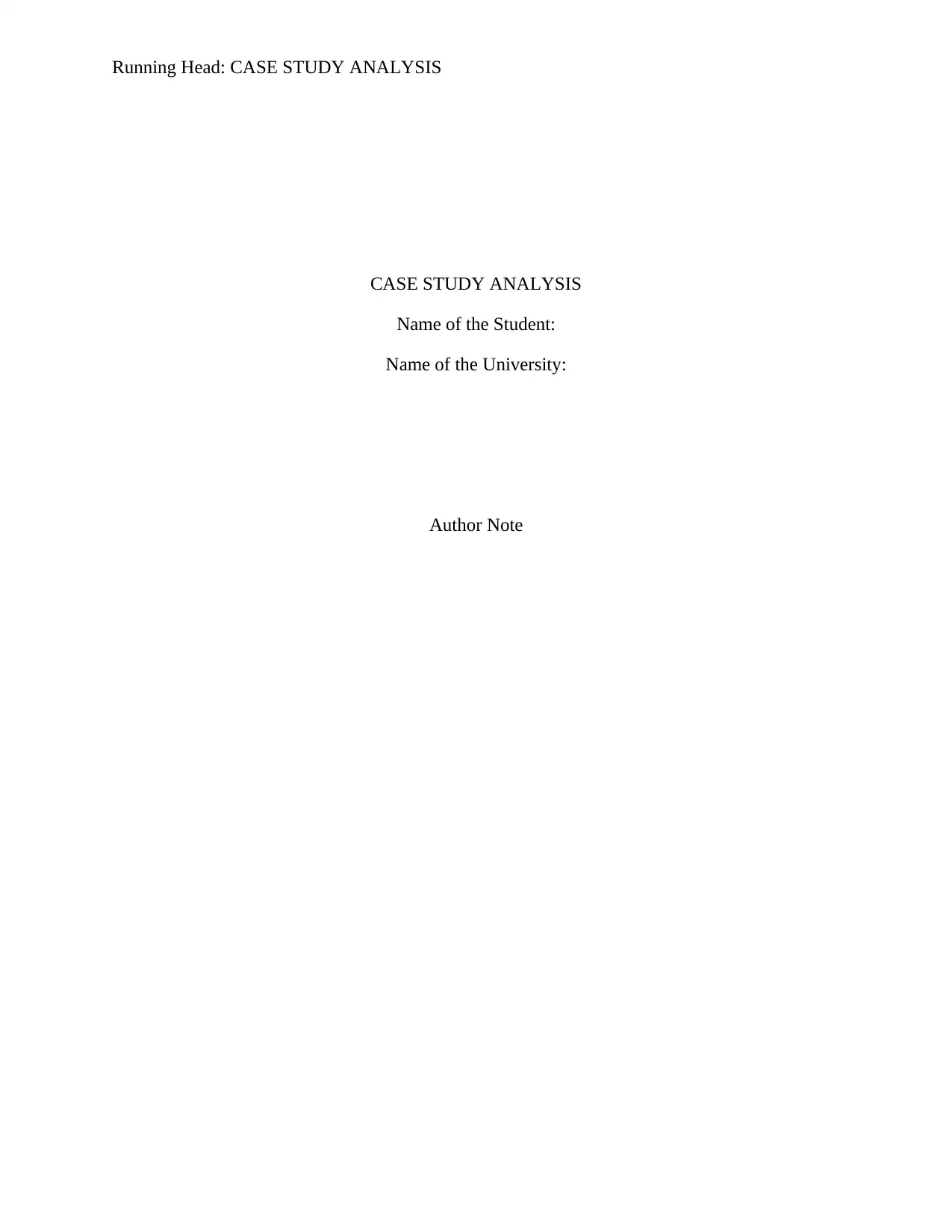
Running Head: CASE STUDY ANALYSIS
CASE STUDY ANALYSIS
Name of the Student:
Name of the University:
Author Note
CASE STUDY ANALYSIS
Name of the Student:
Name of the University:
Author Note
Paraphrase This Document
Need a fresh take? Get an instant paraphrase of this document with our AI Paraphraser
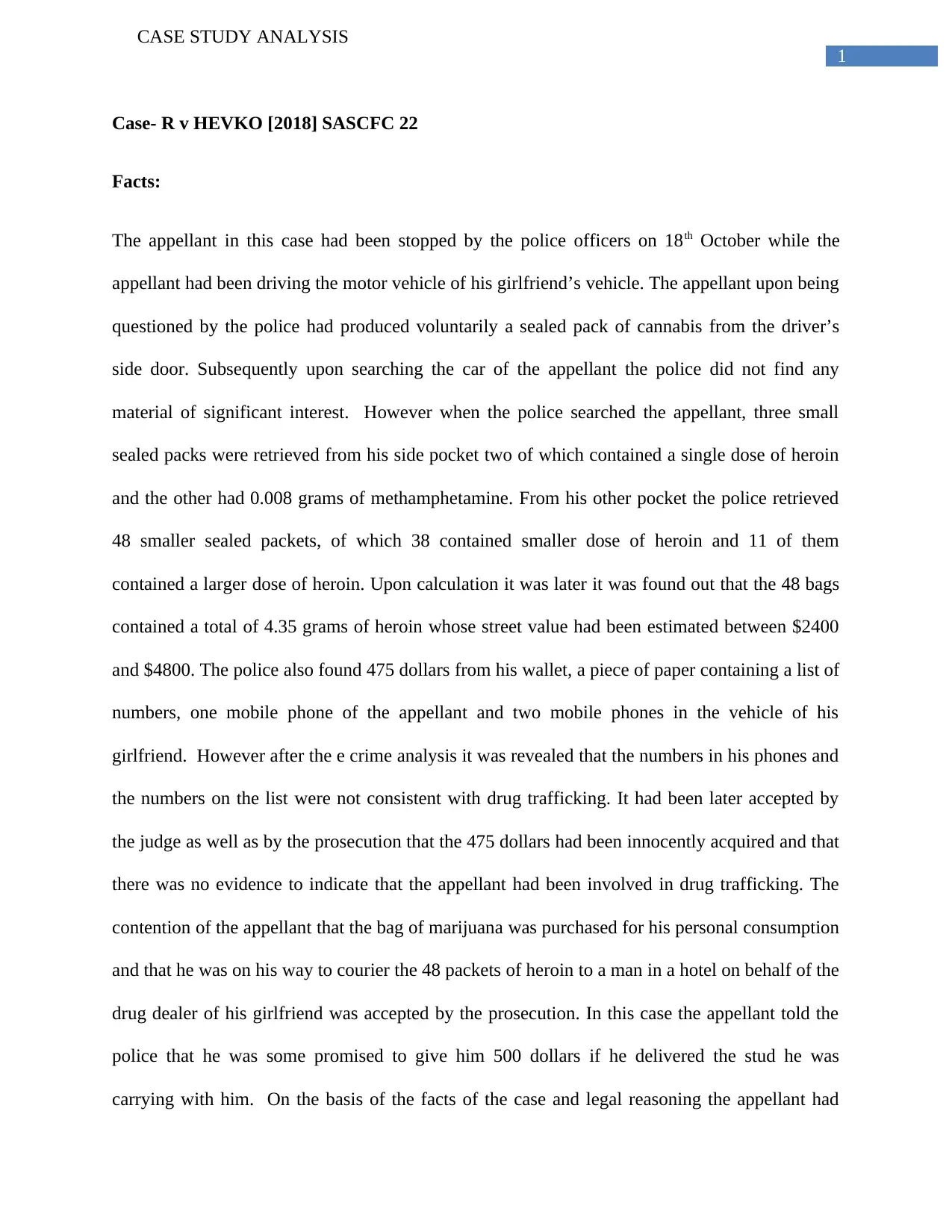
1
CASE STUDY ANALYSIS
Case- R v HEVKO [2018] SASCFC 22
Facts:
The appellant in this case had been stopped by the police officers on 18th October while the
appellant had been driving the motor vehicle of his girlfriend’s vehicle. The appellant upon being
questioned by the police had produced voluntarily a sealed pack of cannabis from the driver’s
side door. Subsequently upon searching the car of the appellant the police did not find any
material of significant interest. However when the police searched the appellant, three small
sealed packs were retrieved from his side pocket two of which contained a single dose of heroin
and the other had 0.008 grams of methamphetamine. From his other pocket the police retrieved
48 smaller sealed packets, of which 38 contained smaller dose of heroin and 11 of them
contained a larger dose of heroin. Upon calculation it was later it was found out that the 48 bags
contained a total of 4.35 grams of heroin whose street value had been estimated between $2400
and $4800. The police also found 475 dollars from his wallet, a piece of paper containing a list of
numbers, one mobile phone of the appellant and two mobile phones in the vehicle of his
girlfriend. However after the e crime analysis it was revealed that the numbers in his phones and
the numbers on the list were not consistent with drug trafficking. It had been later accepted by
the judge as well as by the prosecution that the 475 dollars had been innocently acquired and that
there was no evidence to indicate that the appellant had been involved in drug trafficking. The
contention of the appellant that the bag of marijuana was purchased for his personal consumption
and that he was on his way to courier the 48 packets of heroin to a man in a hotel on behalf of the
drug dealer of his girlfriend was accepted by the prosecution. In this case the appellant told the
police that he was some promised to give him 500 dollars if he delivered the stud he was
carrying with him. On the basis of the facts of the case and legal reasoning the appellant had
CASE STUDY ANALYSIS
Case- R v HEVKO [2018] SASCFC 22
Facts:
The appellant in this case had been stopped by the police officers on 18th October while the
appellant had been driving the motor vehicle of his girlfriend’s vehicle. The appellant upon being
questioned by the police had produced voluntarily a sealed pack of cannabis from the driver’s
side door. Subsequently upon searching the car of the appellant the police did not find any
material of significant interest. However when the police searched the appellant, three small
sealed packs were retrieved from his side pocket two of which contained a single dose of heroin
and the other had 0.008 grams of methamphetamine. From his other pocket the police retrieved
48 smaller sealed packets, of which 38 contained smaller dose of heroin and 11 of them
contained a larger dose of heroin. Upon calculation it was later it was found out that the 48 bags
contained a total of 4.35 grams of heroin whose street value had been estimated between $2400
and $4800. The police also found 475 dollars from his wallet, a piece of paper containing a list of
numbers, one mobile phone of the appellant and two mobile phones in the vehicle of his
girlfriend. However after the e crime analysis it was revealed that the numbers in his phones and
the numbers on the list were not consistent with drug trafficking. It had been later accepted by
the judge as well as by the prosecution that the 475 dollars had been innocently acquired and that
there was no evidence to indicate that the appellant had been involved in drug trafficking. The
contention of the appellant that the bag of marijuana was purchased for his personal consumption
and that he was on his way to courier the 48 packets of heroin to a man in a hotel on behalf of the
drug dealer of his girlfriend was accepted by the prosecution. In this case the appellant told the
police that he was some promised to give him 500 dollars if he delivered the stud he was
carrying with him. On the basis of the facts of the case and legal reasoning the appellant had
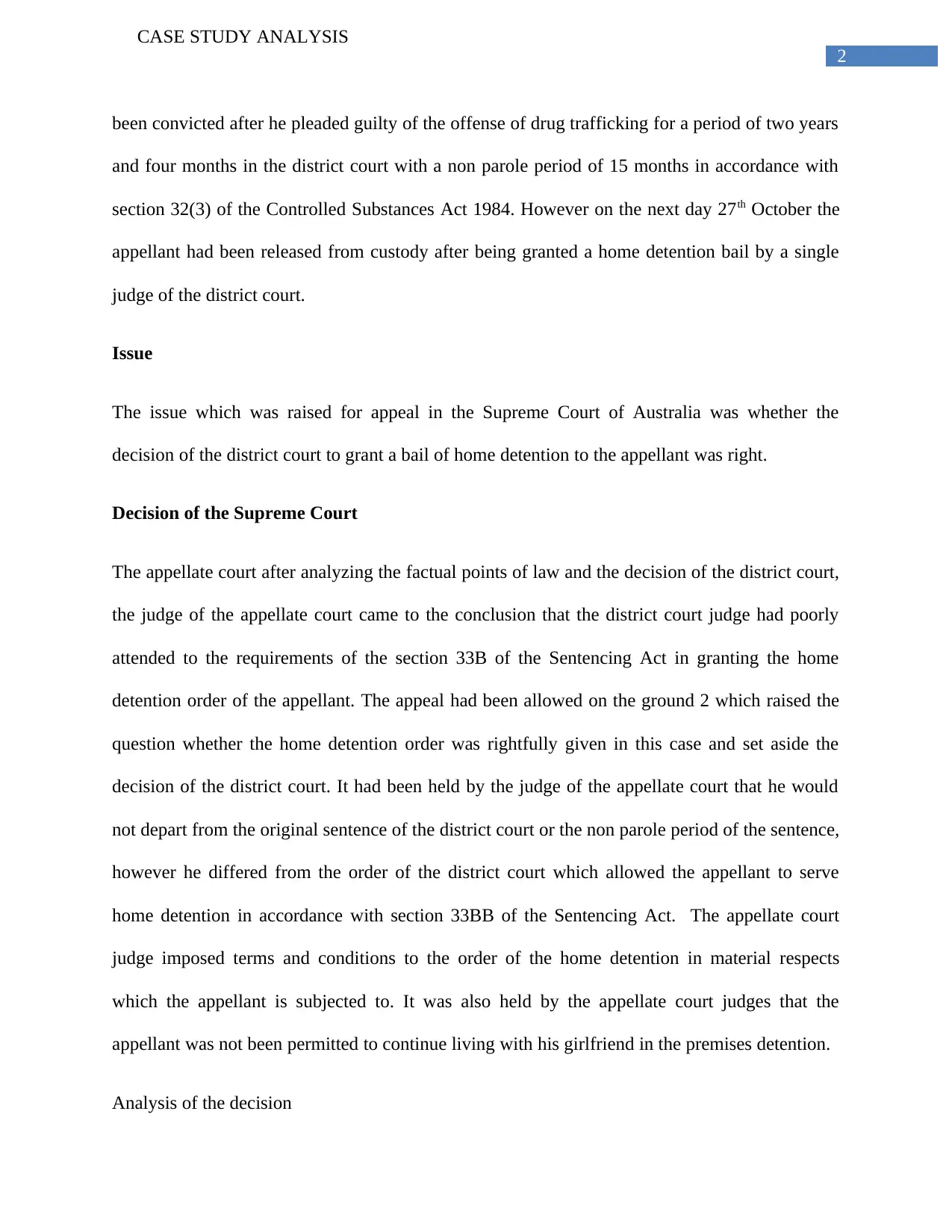
2
CASE STUDY ANALYSIS
been convicted after he pleaded guilty of the offense of drug trafficking for a period of two years
and four months in the district court with a non parole period of 15 months in accordance with
section 32(3) of the Controlled Substances Act 1984. However on the next day 27th October the
appellant had been released from custody after being granted a home detention bail by a single
judge of the district court.
Issue
The issue which was raised for appeal in the Supreme Court of Australia was whether the
decision of the district court to grant a bail of home detention to the appellant was right.
Decision of the Supreme Court
The appellate court after analyzing the factual points of law and the decision of the district court,
the judge of the appellate court came to the conclusion that the district court judge had poorly
attended to the requirements of the section 33B of the Sentencing Act in granting the home
detention order of the appellant. The appeal had been allowed on the ground 2 which raised the
question whether the home detention order was rightfully given in this case and set aside the
decision of the district court. It had been held by the judge of the appellate court that he would
not depart from the original sentence of the district court or the non parole period of the sentence,
however he differed from the order of the district court which allowed the appellant to serve
home detention in accordance with section 33BB of the Sentencing Act. The appellate court
judge imposed terms and conditions to the order of the home detention in material respects
which the appellant is subjected to. It was also held by the appellate court judges that the
appellant was not been permitted to continue living with his girlfriend in the premises detention.
Analysis of the decision
CASE STUDY ANALYSIS
been convicted after he pleaded guilty of the offense of drug trafficking for a period of two years
and four months in the district court with a non parole period of 15 months in accordance with
section 32(3) of the Controlled Substances Act 1984. However on the next day 27th October the
appellant had been released from custody after being granted a home detention bail by a single
judge of the district court.
Issue
The issue which was raised for appeal in the Supreme Court of Australia was whether the
decision of the district court to grant a bail of home detention to the appellant was right.
Decision of the Supreme Court
The appellate court after analyzing the factual points of law and the decision of the district court,
the judge of the appellate court came to the conclusion that the district court judge had poorly
attended to the requirements of the section 33B of the Sentencing Act in granting the home
detention order of the appellant. The appeal had been allowed on the ground 2 which raised the
question whether the home detention order was rightfully given in this case and set aside the
decision of the district court. It had been held by the judge of the appellate court that he would
not depart from the original sentence of the district court or the non parole period of the sentence,
however he differed from the order of the district court which allowed the appellant to serve
home detention in accordance with section 33BB of the Sentencing Act. The appellate court
judge imposed terms and conditions to the order of the home detention in material respects
which the appellant is subjected to. It was also held by the appellate court judges that the
appellant was not been permitted to continue living with his girlfriend in the premises detention.
Analysis of the decision
⊘ This is a preview!⊘
Do you want full access?
Subscribe today to unlock all pages.

Trusted by 1+ million students worldwide
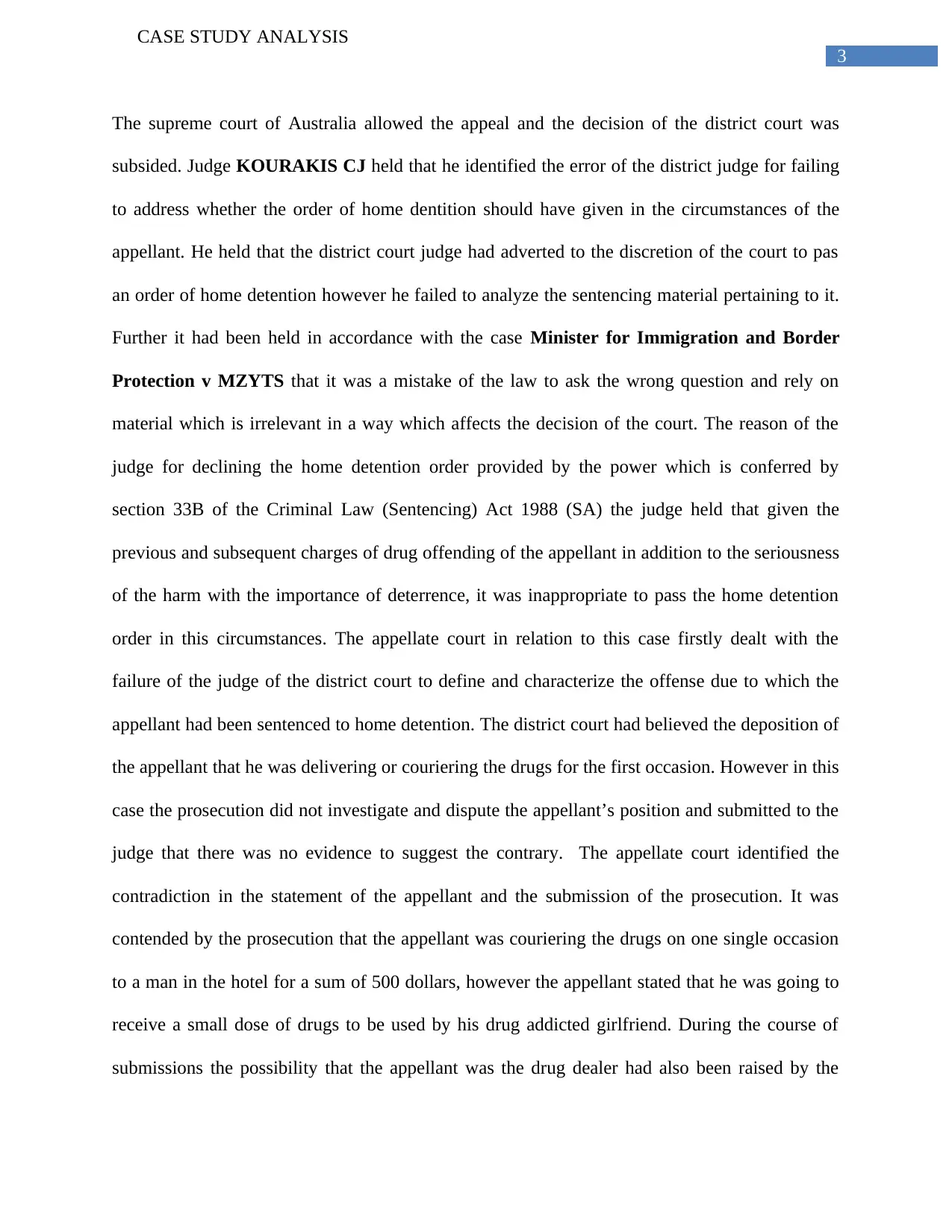
3
CASE STUDY ANALYSIS
The supreme court of Australia allowed the appeal and the decision of the district court was
subsided. Judge KOURAKIS CJ held that he identified the error of the district judge for failing
to address whether the order of home dentition should have given in the circumstances of the
appellant. He held that the district court judge had adverted to the discretion of the court to pas
an order of home detention however he failed to analyze the sentencing material pertaining to it.
Further it had been held in accordance with the case Minister for Immigration and Border
Protection v MZYTS that it was a mistake of the law to ask the wrong question and rely on
material which is irrelevant in a way which affects the decision of the court. The reason of the
judge for declining the home detention order provided by the power which is conferred by
section 33B of the Criminal Law (Sentencing) Act 1988 (SA) the judge held that given the
previous and subsequent charges of drug offending of the appellant in addition to the seriousness
of the harm with the importance of deterrence, it was inappropriate to pass the home detention
order in this circumstances. The appellate court in relation to this case firstly dealt with the
failure of the judge of the district court to define and characterize the offense due to which the
appellant had been sentenced to home detention. The district court had believed the deposition of
the appellant that he was delivering or couriering the drugs for the first occasion. However in this
case the prosecution did not investigate and dispute the appellant’s position and submitted to the
judge that there was no evidence to suggest the contrary. The appellate court identified the
contradiction in the statement of the appellant and the submission of the prosecution. It was
contended by the prosecution that the appellant was couriering the drugs on one single occasion
to a man in the hotel for a sum of 500 dollars, however the appellant stated that he was going to
receive a small dose of drugs to be used by his drug addicted girlfriend. During the course of
submissions the possibility that the appellant was the drug dealer had also been raised by the
CASE STUDY ANALYSIS
The supreme court of Australia allowed the appeal and the decision of the district court was
subsided. Judge KOURAKIS CJ held that he identified the error of the district judge for failing
to address whether the order of home dentition should have given in the circumstances of the
appellant. He held that the district court judge had adverted to the discretion of the court to pas
an order of home detention however he failed to analyze the sentencing material pertaining to it.
Further it had been held in accordance with the case Minister for Immigration and Border
Protection v MZYTS that it was a mistake of the law to ask the wrong question and rely on
material which is irrelevant in a way which affects the decision of the court. The reason of the
judge for declining the home detention order provided by the power which is conferred by
section 33B of the Criminal Law (Sentencing) Act 1988 (SA) the judge held that given the
previous and subsequent charges of drug offending of the appellant in addition to the seriousness
of the harm with the importance of deterrence, it was inappropriate to pass the home detention
order in this circumstances. The appellate court in relation to this case firstly dealt with the
failure of the judge of the district court to define and characterize the offense due to which the
appellant had been sentenced to home detention. The district court had believed the deposition of
the appellant that he was delivering or couriering the drugs for the first occasion. However in this
case the prosecution did not investigate and dispute the appellant’s position and submitted to the
judge that there was no evidence to suggest the contrary. The appellate court identified the
contradiction in the statement of the appellant and the submission of the prosecution. It was
contended by the prosecution that the appellant was couriering the drugs on one single occasion
to a man in the hotel for a sum of 500 dollars, however the appellant stated that he was going to
receive a small dose of drugs to be used by his drug addicted girlfriend. During the course of
submissions the possibility that the appellant was the drug dealer had also been raised by the
Paraphrase This Document
Need a fresh take? Get an instant paraphrase of this document with our AI Paraphraser
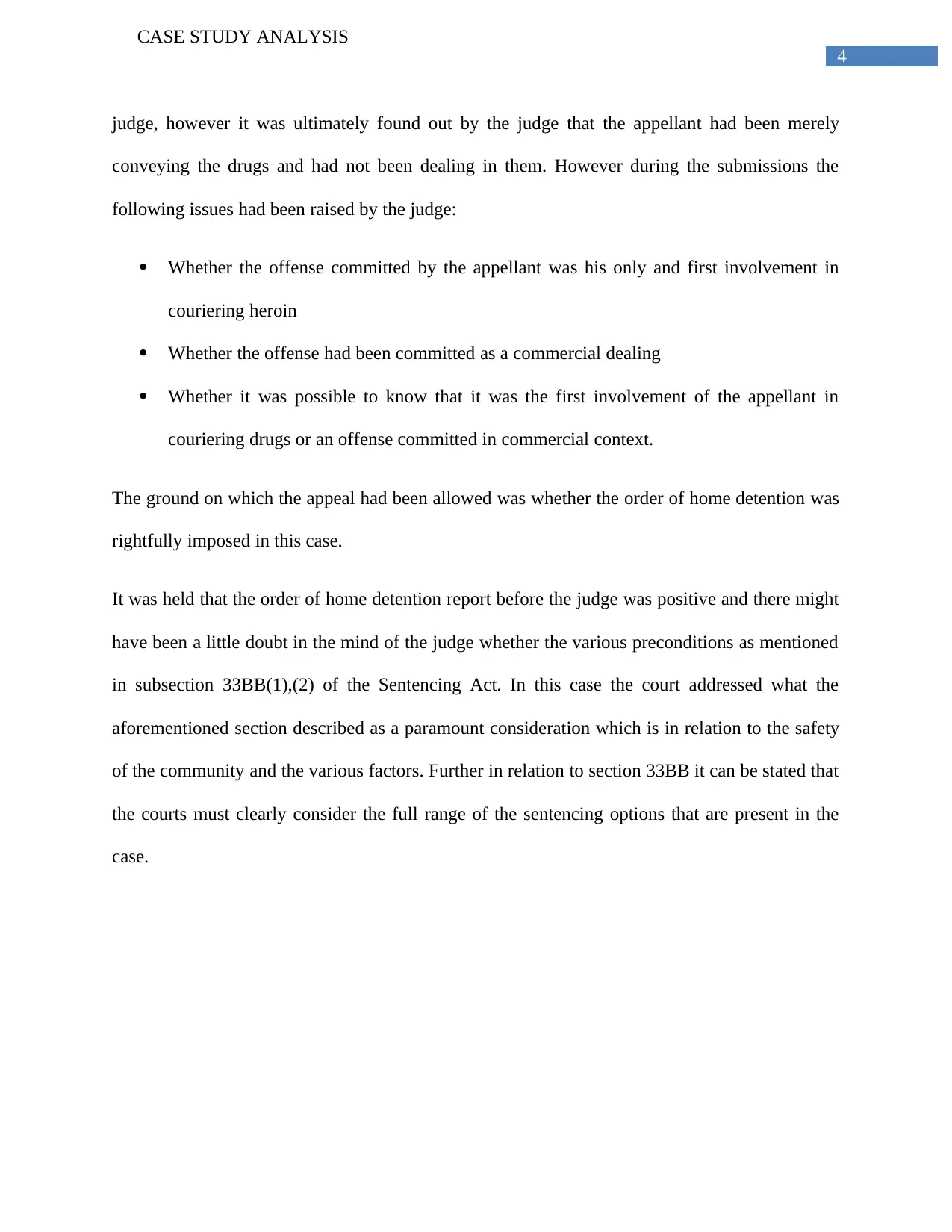
4
CASE STUDY ANALYSIS
judge, however it was ultimately found out by the judge that the appellant had been merely
conveying the drugs and had not been dealing in them. However during the submissions the
following issues had been raised by the judge:
Whether the offense committed by the appellant was his only and first involvement in
couriering heroin
Whether the offense had been committed as a commercial dealing
Whether it was possible to know that it was the first involvement of the appellant in
couriering drugs or an offense committed in commercial context.
The ground on which the appeal had been allowed was whether the order of home detention was
rightfully imposed in this case.
It was held that the order of home detention report before the judge was positive and there might
have been a little doubt in the mind of the judge whether the various preconditions as mentioned
in subsection 33BB(1),(2) of the Sentencing Act. In this case the court addressed what the
aforementioned section described as a paramount consideration which is in relation to the safety
of the community and the various factors. Further in relation to section 33BB it can be stated that
the courts must clearly consider the full range of the sentencing options that are present in the
case.
CASE STUDY ANALYSIS
judge, however it was ultimately found out by the judge that the appellant had been merely
conveying the drugs and had not been dealing in them. However during the submissions the
following issues had been raised by the judge:
Whether the offense committed by the appellant was his only and first involvement in
couriering heroin
Whether the offense had been committed as a commercial dealing
Whether it was possible to know that it was the first involvement of the appellant in
couriering drugs or an offense committed in commercial context.
The ground on which the appeal had been allowed was whether the order of home detention was
rightfully imposed in this case.
It was held that the order of home detention report before the judge was positive and there might
have been a little doubt in the mind of the judge whether the various preconditions as mentioned
in subsection 33BB(1),(2) of the Sentencing Act. In this case the court addressed what the
aforementioned section described as a paramount consideration which is in relation to the safety
of the community and the various factors. Further in relation to section 33BB it can be stated that
the courts must clearly consider the full range of the sentencing options that are present in the
case.
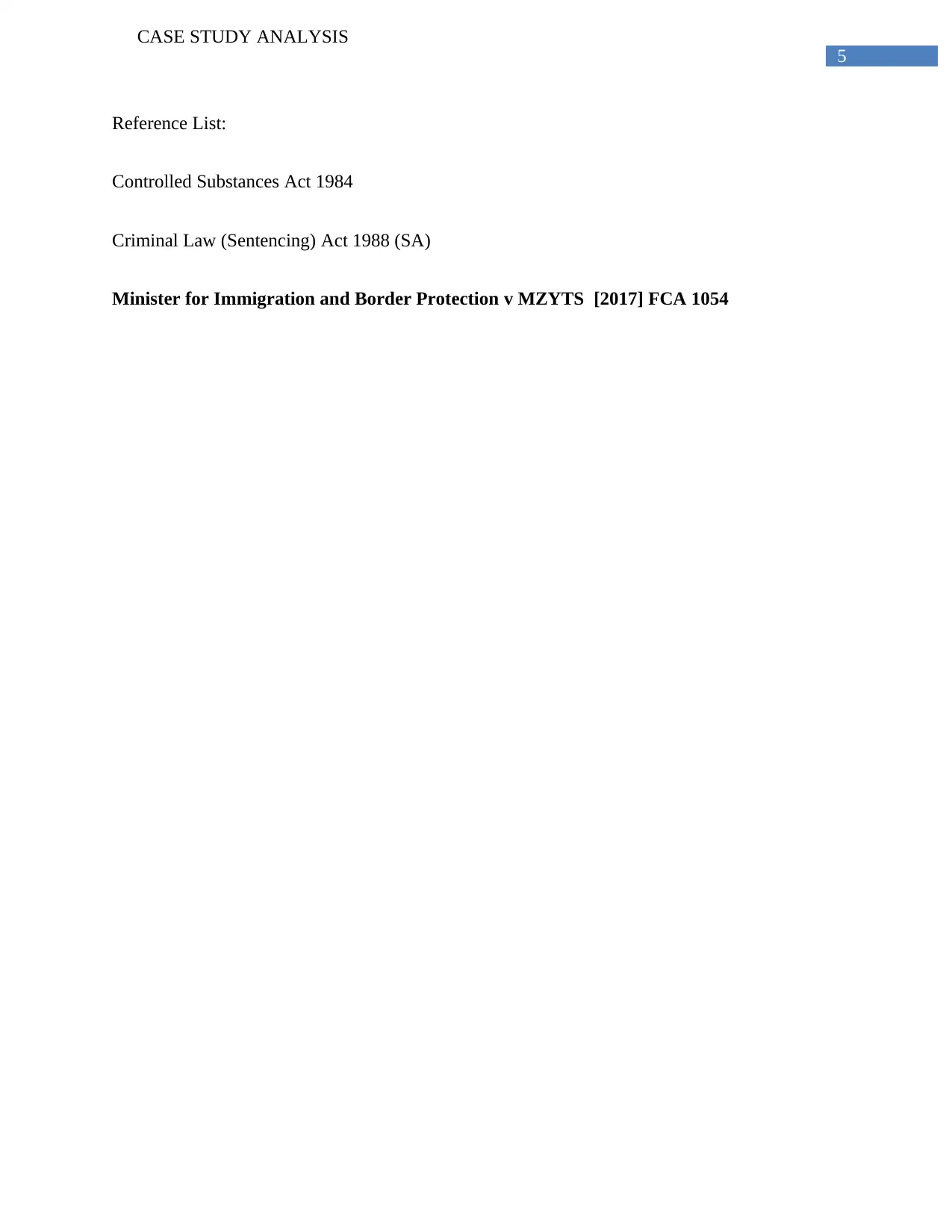
5
CASE STUDY ANALYSIS
Reference List:
Controlled Substances Act 1984
Criminal Law (Sentencing) Act 1988 (SA)
Minister for Immigration and Border Protection v MZYTS [2017] FCA 1054
CASE STUDY ANALYSIS
Reference List:
Controlled Substances Act 1984
Criminal Law (Sentencing) Act 1988 (SA)
Minister for Immigration and Border Protection v MZYTS [2017] FCA 1054
⊘ This is a preview!⊘
Do you want full access?
Subscribe today to unlock all pages.

Trusted by 1+ million students worldwide
1 out of 6
Your All-in-One AI-Powered Toolkit for Academic Success.
+13062052269
info@desklib.com
Available 24*7 on WhatsApp / Email
![[object Object]](/_next/static/media/star-bottom.7253800d.svg)
Unlock your academic potential
Copyright © 2020–2025 A2Z Services. All Rights Reserved. Developed and managed by ZUCOL.